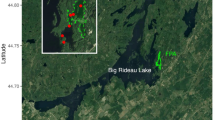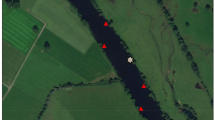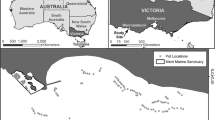Abstract
Southern flounder Paralichthys lethostigma populations have been declining in Texas during the past 25 years. Despite their economic importance, little is known about their juvenile habitat requirements. We examined habitat use patterns of newly settled southern flounder in three zones at varying distances from the Aransas Pass inlet in Aransas–Copano Bay by measuring densities using a beam trawl in replicate estuarine habitat types in each zone. Highest abundance occurred near the inlet in vegetated sandy areas and was lowest in nonvegetated muddy bottom in regions furthest from the inlet. We also examined a 25-year fisheries data set from Texas Parks and Wildlife Department to evaluate long-term spatiotemporal recruitment patterns in Aransas–Copano Bay. These data showed generally low recruitment during the past 25 years with highest abundance near the inlets. Our results support the importance of vegetated habitat types, especially those near tidal passes, and suggest a long-term decline in recruitment densities of southern flounder.





Similar content being viewed by others
References
Allen, R.L., and D.M. Baltz. 1997. Distribution and microhabitat use by flatfishes in a Louisiana estuary. Environmental Biology of Fishes 50: 85–103. doi:10.1023/A:1007398517163.
Baltz, D.M., C. Rakocinski, and J.W. Fleeger. 1993. Microhabitat use by marsh-edge fishes in a Louisiana estuary. Environmental Biology of Fishes 36: 109–126. doi:10.1007/BF00002790.
Beck, M.W., K.L. Heck, K.W. Able, D.L. Childers, D.B. Eggleston, B.M. Gillanders, B. Halpern, C.G. Hays, K. Hoshino, T.J. Minello, R.J. Orth, P.F. Sheridan, and M.R. Weinstein. 2001. The identification, conservation, and management of estuarine and marine nurseries for fish and invertebrates. Bioscience 51: 633–641.
Bell, J.D., A.S. Steffe, and M. Westoby. 1988. Location of seagrass beds in estuaries: effects on associated fish and decapods. Journal of Experimental Marine Biology and Ecology 122: 127–146. doi:10.1016/0022-0981(88)90180-3.
Boehlert, G.W., and B.C. Mundy. 1988. Roles of behavioral and physical factors in larval and juvenile fish recruitment to estuarine nursery areas. American Fisheries Society Symposium 3: 51–67.
Boesch, D.F., and R.E. Turner. 1984. Dependence of fishery species on salt marshes: the role of food and refuge. Estuaries 7: 460–468. doi:10.2307/1351627.
Britton, J.C., and B. Morton. 1989. Shore ecology of the Gulf of Mexico. Austin, Texas: University of Texas Press.
Brown, C.A., S.A. Holt, G.A. Jackson, D.A. Brooks, and G.J. Holt. 2004. Simulating larval supply to estuarine nursery areas: how important are physical processes to the supply of larvae to the Aransas Pass Inlet? Fish Oceanography 13: 181–196. doi:10.1111/j.1365-2419.2004.00285.x.
Burke, J.S., J.M. Miller, and D.E. Hoss. 1991. Immigration and settlement pattern of Paralichthys dentatus and P. lethostigma in an estuarine nursery ground, North Carolina, U.S.A. Netherlands Journal of Sea Research 27: 393–405. doi:10.1016/0077-7579(91)90041-X.
Burke, J.S., M. Ueno, Y. Tanaka, H. Walsh, T. Maeda, I. Kinoshita, T. Seikai, D.E. Hoss, and M. Tanaka. 1998. The influence of environmental factors on early life history patterns of flounders. Netherlands Journal of Sea Research 40: 19–32.
Carr, W., and C.A. Adams. 1973. The food habits of juvenile marine fishes occupying seagrass beds in the estuarine zone near Crystal River, Florida. Transactions of the American Fisheries Society 102: 511–540. doi:10.1577/1548-8659(1973)102<511:FHOJMF>2.0.CO;2.
Clarke, K.R., and R.N. Gorley. 2006. PRIMER v6: user manual/tutorial. PRIMER-E, Plymouth, United Kingdom.
Clarke, K.R., and R.M. Warwick. 2001. Change in marine communities: an approach to statistical analysis and interpretation, 2nd edition. PRIMER-E, Plymouth, United Kingdom.
Doherty, P.J. 1982. Some effects of density on the juvenile of two species of tropical territorial damselfishes. Journal of Experimental Marine Biology and Ecology 65: 249–261. doi:10.1016/0022-0981(82)90057-0.
Folk, R.L. 1980. Petrology of sedimentary rocks. Austin, Texas: Hemphill Publishing Company.
Gibson, R.N. 1994. Impact of habitat quality and quantity on the recruitment of juvenile flatfishes. Netherlands Journal of Sea Research 322: 191–206. doi:10.1016/0077-7579(94)90040-X.
Gulf States Marine Fisheries Commission. 2000. The flounder fishery of the Gulf of Mexico, United States: A regional management plan. Publication # 83, GSMFC, Ocean Springs, Mississippi.
Heck, K.L., and R.J. Orth. 1980. Seagrass habitats: the roles of habitat complexity, competition, competition and predation in structuring assisted fish and motile macroinvertebrate assemblages. New York, New York: Estuarine perspective. Academic Press.
Heck, K.L., and R.J. Orth. 2003. Critical evaluation of the nursery role hypothesis for seagrass meadows. Marine Ecology Progress Series 253: 123–136. doi:10.3354/meps253123.
Heck, K.L., and T.A. Thoman. 1984. The nursery role of seagrass meadows in the upper and lower reaches of the Chesapeake Bay. Estuaries 7: 70–92. doi:10.2307/1351958.
Houde, E.D. 1987. Fish early life dynamics and recruitment variability. American Fisheries Society Symposium 2: 17–29.
Keefe, M.L., and K.W. Able. 1994. Contributions of abiotic and biotic factors to settlement in summer flounder, Paralichthys dentatus. Copeia 2: 458–465. doi:10.2307/1446993.
King, B.D. 1971. Study of migratory patterns of fish and shellfish through a natural pass. Texas Parks and Wildlife Department Technical Series 9: 1–37.
Kneib, R.T. 1984. Patterns of invertebrate distribution and abundance in the intertidal salt marsh: causes and questions. Estuaries 7: 392–412. doi:10.2307/1351621.
Kneib, R.T. 1993. Growth and mortality in successive cohorts of fish larvae within an estuarine nursery. Marine Ecology Progress Series 94: 115–127. doi:10.3354/meps094115.
Levin, P.S. 1994. Small-scale recruitment variation in temperate fish: the roles of macrophytes and food supply. Environmental Biology of Fishes 40: 271–281. doi:10.1007/BF00002517.
Levin, P.S., and M.E. Hay. 1996. Responses of temperate reef fishes to alterations in algal structure and species composition. Marine Ecology Progress Series 14: 37–47. doi:10.3354/meps134037.
Manderson, J.P., B.A. Phelan, C. Meise, L.L. Stehlik, A.J. Bejda, J. Pessutti, L. Arlen, A. Draxler, and A.W. Stoner. 2002. Spatial dynamics of habitat suitability for the growth of newly settled winter flounder Pseudopleuronectes americanus in an estuarine nursery. Marine Ecology Progress Series 228: 227–239. doi:10.3354/meps228227.
Martinez-Andrade, F., P. Campbell, and B. Fuls. 2005. Trends in relative abundance and size of Selected finfishes and shellfishes along the Texas coast: November 1975–December 2003. Management Data Series No. 232. Texas Parks and Wildlife: Coastal Fisheries Division.
Minello, T.J. 1999. Nekton densities in shallow estuarine habitats of Texas and Louisiana and the identification of essential fish habitat. American Fisheries Society Symposium 22: 43–75.
Minello, T.J., and R.J. Zimmerman. 1992. Utilization of natural and transplanted Texas salt marshes by fish and decapod crustaceans. Marine Ecology Progress Series 90: 273–285. doi:10.3354/meps090273.
Minello, T.J., R.J. Zimmerman, and R. Medina. 1994. The importance of edge for natant macrofauna in a created salt marsh. Wetlands 14: 184–198.
Moles, A., and B.L. Norcross. 1995. Sediment preference in juvenile Pacific flatfishes. Netherlands Journal of Sea Research 34: 177–182. doi:10.1016/0077-7579(95)90025-X.
Nasir, N.A., and M.G. Poxton. 2001. Substratum preferences of juvenile flatfish. Cybium 252: 109–117.
Peterson, G.W., and R.E. Turner. 1994. The value of salt marsh edge versus interior as a habitat for fish and decapod crustaceans in a Louisiana tidal marsh. Estuaries 17: 235–262. doi:10.2307/1352573.
Powell, A.B., and F.J. Schwartz. 1977. Distribution of paralichthids flounders (Bothidae: Paralichthys) in North Carolina estuaries. Chesapeake Science 18: 334–339. doi:10.2307/1350587.
Rooker, J.R., S.A. Holt, M.A. Soto, and G.J. Holt. 1998. Post-settlement patterns of habitat use by Sciaenid fishes in subtropical seagrass meadows. Estuaries 212: 318–327. doi:10.2307/1352478.
Rose, K.A., J.H. Cowan, K.O. Winemiller, R.A. Myers, and R. Hilbor. 2001. Compensatory density dependence in fish populations: importance, controversy, understanding and prognosis. Fish and Fisheries 2: 293–327. doi:10.1046/j.1467-2960.2001.00056.x.
Rozas, L.P., and C.T. Hackney. 1984. Use of oligohaline marshes by fishes and macrofaunal crustaceans in North Carolina. Estuaries 73: 213–224. doi:10.2307/1352141.
Rozas, L.P., and M.W. LaSalle. 1990. A comparison of the diets of gulf killifish, Fundulus grandis Baird and Girard, entering and leaving a Mississippi marsh. Estuaries 13: 332–336. doi:10.2307/1351924.
Rozas, L.P., and T.J. Minello. 1997. Estimating densities of small fishes and decapod crustaceans in shallow estuarine habitats: a review of sampling design with focus on gear selection. Estuaries 20: 199–213. doi:10.2307/1352731.
Rozas, L.P., and T.J. Minello. 1998. Nekton use of salt marsh, seagrass, and non-vegetated habitats in a south Texas (USA) estuary. Bulletin of Marine Science 63: 481–501.
Rozas, L.P., and W.E. Odum. 1988. Occupation of submerged aquatic vegetation by fishes: testing the roles of food and refuge. Oecologia 77: 101–106. doi:10.1007/BF00380932.
Sheridan, P.G., G. McMahan, K. Hammerstrom, and W. Pulich Jr. 1998. Factors affecting restoration of Halodule wrightii to Galveston Bay, Texas. Restoration Ecology 6: 144–158. doi:10.1111/j.1526-100X.1998.00625.x.
Short, F.T., and S. Wyllie-Echeverria. 1996. Natural and human-induced disturbance of seagrasses. Environmental Conservation 23: 17–27.
Sogard, S.M. 1992. Variability in growth rates of juvenile fishes in different estuarine habitats. Marine Ecology Progress Series 85: 35–53. doi:10.3354/meps085035.
Stokes, G.M. 1977. Life histories studies of southern flounder (Paralichthys lethostigma) and gulf flounder (P. albigutta) in the Aransas Bay area of Texas. Texas Parks and Wildlife Department Technical Series 25: 1–37.
Stunz, G.W., T.J. Minello, and P.S. Levin. 2002a. A comparison of early juvenile red drum densities among various habitat types in Galveston Bay, Texas. Estuaries 25: 76–85. doi:10.1007/BF02696051.
Stunz, G.W., T.J. Minello, and P.S. Levin. 2002b. Growth of newly settled red drum Sciaenops ocellatus in different estuarine habitat types. Marine Ecology Progress Series 238: 227–236. doi:10.3354/meps238227.
Tanada, M. 1990. Studies on burying ability in sand and selection to the grain size for hatchery-reared marbled sole and Japanese flounder. Nippon Suisan Gakkaishi 5610: 1543–1548.
Teal, J.M. 1962. Energy flow in the salt marsh ecosystem of Georgia. Ecology 43: 614–624. doi:10.2307/1933451.
Texas Parks and Wildlife Department. 2003. Saltwater finfish research and management in Texas: a report to the Governor and the 78th Legislature, Austin, Texas.
USEPA. 1999. Ecological condition of estuaries in the Gulf of Mexico. EPA 620-R-98–004. U.S. Environmental Protection Agency, Office of Research and Development, National Health and Environmental Effects Research Laboratory, Gulf Ecology Division, Gulf Breeze, Florida.
Walsh, H.J., D.S. Peters, and D.P. Cyrus. 1999. Habitat utilization by small flatfishes in a North Carolina estuary. Estuaries 22: 803–813. doi:10.2307/1353113.
Weinstein, M.P. 1979. Shallow marsh habitats as primary nurseries for fishes and shellfish, Cape Fear River, North Carolina. Fishery Bulletin US 77: 339–357.
Zimmerman, R.J., T.J. Minello, M.C. Castiglione, and D.L. Smith. 1990. Utilization of marsh and associated habitats along a salinity gradient in Galveston Bay. NOAA Technical Memo, NMFS-SEFC-250.
Acknowledgements
We gratefully acknowledge Texas Sea Grant (Grant no. NA16RG078), Coastal Conservation Association and Texas A&M University—Corpus Christi for funding this project. We would also like to thank UTMSI, particularly Dr. Paul Montagna and Rick Kalke, for their assistance with sediment analysis, as well as Cameron Pratt and Jason Williams for their extensive work in the field and the lab. A special thank you to Dr. Mark Fisher, TPWD, for aiding us in obtaining monitoring data and John Wood, HRI, for helping with the spatial analysis. We greatly appreciate the time and effort, comments, suggestions, and advice from the editors and anonymous reviewers that substantially improved this manuscript. Finally, many thanks to the Fisheries Ecology Lab, especially Megan Reese, John Froeschke, Bridgette Froeschke, and Jason James along with many other undergraduates, graduates, and volunteers for their invaluable assistance in the field and laboratory.
Author information
Authors and Affiliations
Corresponding author
Rights and permissions
About this article
Cite this article
Nañez-James, S.E., Stunz, G.W. & Holt, S.A. Habitat Use Patterns of Newly Settled Southern Flounder, Paralichthys lethostigma, in Aransas–Copano Bay, Texas. Estuaries and Coasts 32, 350–359 (2009). https://doi.org/10.1007/s12237-008-9107-y
Received:
Revised:
Accepted:
Published:
Issue Date:
DOI: https://doi.org/10.1007/s12237-008-9107-y




